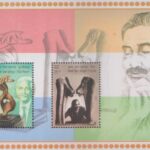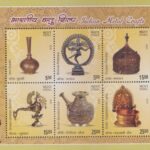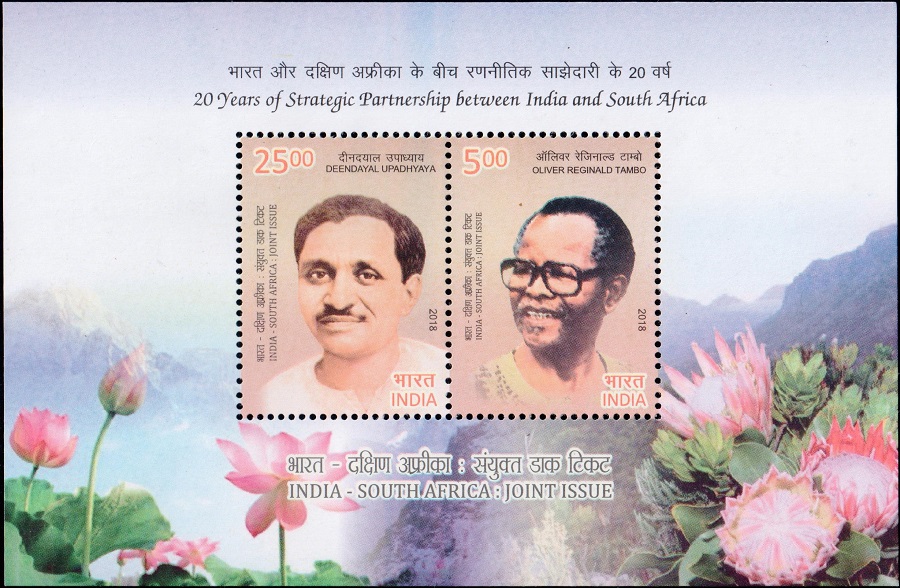
India-Mongolia : Joint Issue
Complete Set of 2 nos of commemorative postage stamps on 50 years of diplomatic relations between India and Mongolia : Joint Issue : Ancient Arts & Crafts :



 Issued by India
Issued by India
Issued on Sep 11, 2006
Issued for : India Post, through this joint release of stamps celebrates the friendship and cooperation between the governments and the peoples of India and Mongolia.
Credits :
Stamp : Designed by Kamleshwar Singh with the help of material provided by the Crafts Museum, New Delhi.
FDC : Designed by Kamleshwar Singh
Cancellation : Designed by Alka Sharma
Type : Miniature Sheet, Mint condition
Colour : Multicolour
Denomination : 1500, 1500 p
Stamps Printed : 0.8 Million, 0.8 Million
Miniature Sheet : 1 Lakh
Printing Process : Photogravure
Printer : India Security Press, Nashik
About :
- Relations between India and Mongolia are characterized by strong civilizational bonds stretching back to three millennia. Over the centuries, literary and spiritual exchanges between the two countries have enriched our cultural ties. The 109 volume Kanjur and the 224 volume Tanjur at the State Public Library, Mongolia are a vivid testimony to our rich literary exchanges. Buddhism remains a very strong link between the two nations.
- These historical links have been renewed and strengthened following the emergence of Mongolia as a modern nation state in the 20th century. After establishment of formal diplomatic relations between the two countries on 24th December, 1955, India has played a supportive role, which facilitated international recognition for Mongolia and its admission as a member of the U.N. in 1961, as also Mongolia‘s entry to various other international bodies including international financial institutions.
- The historical ties between the two countries have also been reinforced by several high level visits over the years. From the Indian side, Vice-President Dr. S. Radhakrishnan paid a historic visit to Mongolia in 1957. His visit was followed by successive Vice Presidents Dr. Shankar Dayal Sharma in 1992; Shri K.R. Narayanan in 1996, and Shri Krishan Kant in 1999. President R. Venkataraman paid a State Visit to Mongolia in July 1988.
- From the Mongolian side, Chairman of the Presidium U. Tsendenbal visited India in 1959. He again visited as the Chairman of the Presidium and Prime Minister of Mongolia in 1973. After the change over to democracy and market economy, President P. Ochirbaat paid a State Visit to India in 1994, when the Treaty of Friendly Relations and Co-operation was signed between the two countries. President N. Bagabandi paid a landmark visit to India in the beginning of the new millennium, which he described ‘as pilgrimage to a sacred land‘. Relations between the two countries were raised to the level of partnership and were given a new impetus during the State Visit of Prime Minister N. Enkhbayar in January 2004, when several new agreements were signed between the two countries. Mongolian Foreign Minister Ts. Munkh-Orgil visited India in December 2005 coinciding with the 50th Anniversary of establishment of diplomatic relations between the two countries.
- The Government of India has also extended modest development assistance to Mongolia, and four Indian-aided institutions have been established in Mongolia. These include – Rajiv Gandhi School of Art and Production set up in 1996, Atal Bihari Vajpayee Centre for Excellence in Information and Communication Technology set up in 2002; Indo-Mongolian Joint Higher Secondary School established in 2003; and a Chair on Sanskrit and Buddhist Studies at the Mongolian National University set up in 2005. There has been considerable increase in bilateral exchanges in recent times, particularly in the fields of education, information technology, solar energy, agriculture, tourism, trade and economy. The two countries also closely coordinate their positions at various international fora.
- As part of the commemoration of 50 years of establishment of diplomatic relations between the two countries, a large number of activities were planned and executed. These included reciprocal naming of streets in New Delhi and Ulaanbaatar, visa-free travel for diplomatic and official passport holders, and a special publication dedicated to the 50th Anniversary of diplomatic relations. The joint issue of Commemorative Postage Stamp by the respective Postal Departments is one such commemorative event.
- The theme of this philatelic commemoration is the rich tradition of arts and crafts of the two countries. One of the stamps depicts an early 20th century bronze replica of the equestrian deity Rao Dev from Bastar, Madhya Pradesh. The extremely fine ornamentation of the bronze idol, cast in the lost wax technique and executed by a Ghadva metalsmith, is typical of the folk metal images from the Bastar region of India. The other stamp depicts an ancient sculpture of a horse from Mongolia, an archaeological finding from the Bronze Age. The bronze cast statue was found in Murun city of Khuvsgul province of Mongolia.
- Text : Based on inputs received from The Ministry of External Affairs, Govt. of India, and Mongol Post Company, Mongolia.







